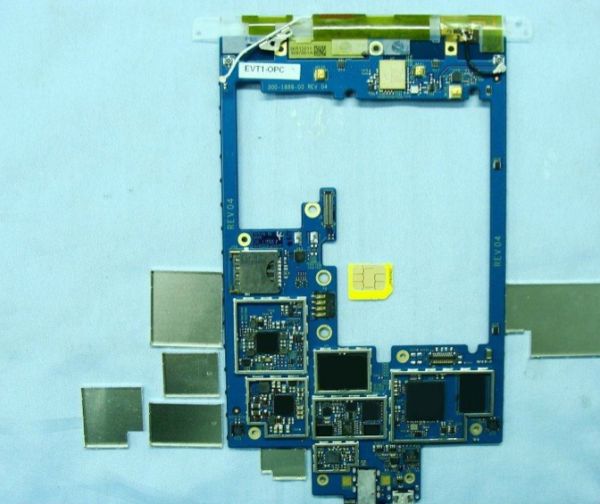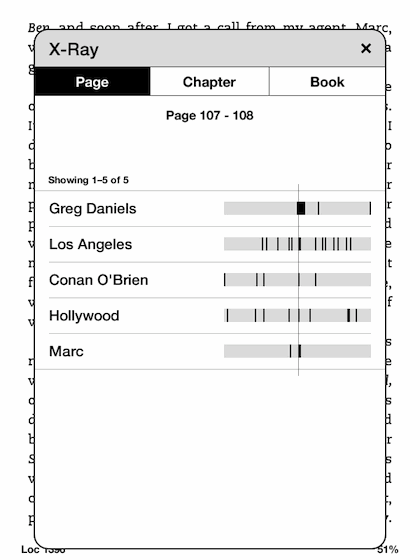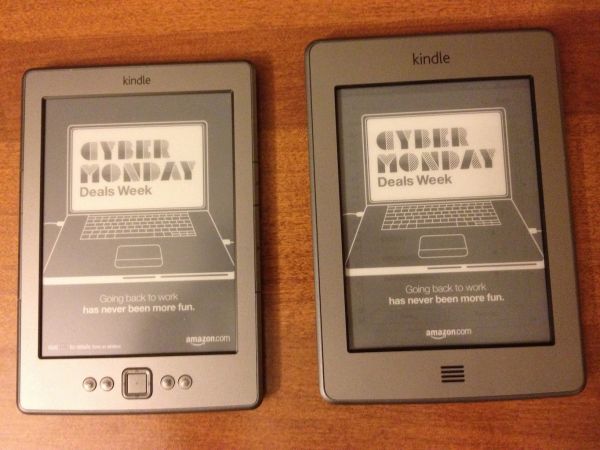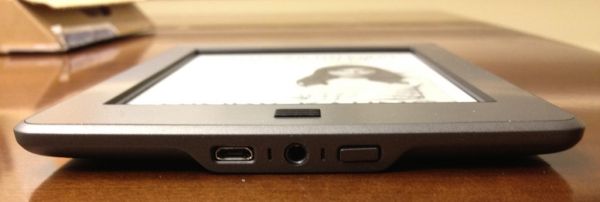Amazon Kindle Touch 3G Review
by Andrew Cunningham on November 28, 2011 11:00 PM EST- Posted in
- Amazon
- ereaders
- Kindle
- Kindle Touch
Amazon announced three new Kindles back in September: the fourth generation Kindle, the Kindle Touch (and Kindle Touch 3G, both of which are identical aside from the 3G antenna), and the Kindle Fire. The Kindle 4 was available on the same day, and we've already taken a good look at it. Our Kindle Fire review is forthcoming. That leaves the Kindle Touch, which we're going to talk about today.
The Kindle Touch is Amazon's first touchscreen e-reader - past Kindles have used nothing but buttons for navigation, even as competing products like Barnes & Noble's Nook Simple Touch began to incorporate touchscreens. At $99 and $149 for the wi-fi and 3G versions ($139 and $189 for the ad-free Kindles), the Kindle Touch is priced competitively, but how does the touchscreen actually impact your reading experience?
Before we get started: Many things we covered in our review of the non-touch Kindle (hereafter referred to as the Kindle 4, to avoid confusion), including screen quality, page refreshes, supported file formats, software updates, and general usage, are still applicable here. If you haven’t read it yet, you should look at our Kindle 4 review before continuing.
Hardware and Software
The Kindle Touch’s box is nearly identical to the Kindle 4's: an unadorned cardboard box containing just the Kindle, a micro USB cable, and a small cardboard insert with basic directions for powering on and charging the device. The manual proper, which has more detailed directions for using the Kindle’s touch controls and other features, is stored on the Kindle itself, and will be launched automatically at first startup.

The first thing you notice when comparing the Kindle Touch to the Kindle 4 is the lack of buttons, of which the Kindle Touch has just two: the Home button situated on the front of the device, which looks vaguely like a speaker grill, and the power/sleep button located on the bottom of the Kindle next to the charge light and headphone jack. Two speaker grills on the back provide basic stereo sound.
The Kindle Touch uses the same 800x600 E-Ink Pearl screen as the Kindle 3 and the Kindle 4 - contrast on my review unit was identical to the less expensive unit. At 6.8” (172mm) x 4.7” (120mm) x 0.40” (10.1mm) and 7.5 ounces (7.8 for the 3G version), the Kindle Touch is still smaller and lighter than the Kindle 3 (7.5" x 4.8" x 0.34" and 8.5 ounces), but is just a bit larger and heavier than the Kindle 4 (6.5" x 4.5" x 0.34" and 5.98 ounces) - the difference is noticeable, especially when the two devices are side by side, but it in no way impacts the reader’s ability to hold the Kindle comfortably in one hand for extended periods of time.
The Kindle Touch’s increased weight is partly due to the larger battery, which at 1420mAh (3.7v) is capable of up to two months of use with the wireless turned off (compared to one month for the Kindle 4).

FCC Internal Photos - Note a microSIM, similar packages and arrangement to the Kindle 4
Micro USB, headphones, and sleep button
Unlike the 3G connectivity of Kindles past, the Kindle Touch 3G’s connection won’t give you free and unfettered access to the Internet. Here, it’s used solely for WhisperSync, for browsing the Kindle Store, downloading purchases, or for looking at Wikipedia - no other sites are available without a wi-fi connection. This move is probably a good business decision on Amazon’s part (and, given the uneven nature of the Kindle’s still-experimental web browser, probably not a terribly disruptive one), but if web surfing is something you do with your current Kindle 3G, prepare to make some adjustments before upgrading to this model.
The Kindle Touch uses version 5.0 of the Kindle software (compared to 4.0 in the non-touch Kindle) - the layout and operation are mostly the same, but the implementation of the touch keyboard and controls and the new X-ray feature were apparently enough to merit the bump in numbering.













31 Comments
View All Comments
aggressor - Tuesday, November 29, 2011 - link
Already echoed in other posts, but this review really needs to match it up against competitors such as the Nook Simple Touch, something by Kobo, and probably something by Sony. It's like reviewing a video card but only showing benchmarks from that particular card and not the competition.xeal - Tuesday, November 29, 2011 - link
I wish there was more (any?) info in the review about how the new Kindle handles books or articles that are not text-only.I assume that most AnandTech readers have a strong interest in technical books and articles. These often include images, diagrams, tables, source code and what not.
What is the experience of reading this type of "rich text" materials on the new Kindle? Did it improve at all compared to previous versions?
Thank you.
Spivonious - Wednesday, November 30, 2011 - link
I've found that f the technical book is in an e-book format (epub, kindle) then it's fine. You lose any colors that would have been there, but it's perfectly legible. If it's only in PDF then you won't be happy. My Nook pulls the text from PDFs fine, but the code samples are interpreted as images, so they're either too small to read or they're placed on a different page from where the text refers to them. Note, this maybe just how the Nook handles PDFs, and might not apply to the Kindle products.If you do read a lot of graphics-heavy text, then you may be better off with an LCD instead of E-ink.
jedivulcan - Tuesday, November 29, 2011 - link
The inability to read/browse internet over 3G pretty much killed all consideration for buying this model. The only (big) issue I had with last generation Kindle with 3G was navigation. When they announced the touch models back in September, I said, "FINALLY!".It's not an excellent web browsing experience. It served its purpose as an on the go way to browse various wikis and blogs. AT&T must have put their foot down when it actually became easy to navigate web pages via a touch screen vs. clicking away on the keyboard and using the directional pad to select links.
Disappointed. It was a nice fallback auxiliary net feature.
JKolstad - Wednesday, November 30, 2011 - link
How can you be disappointed though when you pretty clearly understand the (likely) reason? I'd look at it from the point of view that the Kindle 4's are what one would typically "expect" and the Kindle 3's had this crazy exceptional benefit, where you really were getting something for nothing.BTW, on a Kindle 4 you can browse all of amazon.com via 3G -- not just their store. Granted, for most people that's little difference, although Amazon does have, e.g., forums of their own some people follow.
JKolstad - Wednesday, November 30, 2011 - link
One other thing -- most people seem to be predicting the next Kindle Fire will have 3G and various regular-old-data plan options. Knowing Amazon, I think there's a chance these will be halfway sanely priced, e.g., $25 for 5GB/mo or something like that. Definitely worth keeping an eye on...Sabresiberian - Wednesday, November 30, 2011 - link
Not a tablet user, so all I want is an eReader. The least expensive good one is the one I want.I went with the new Nook Simple Touch on "Black Friday" because they had an in-store sale for $79. With a renew on my Barnes and Noble discount card, it was another $10 off, which made it $69. But really, the main reason I went with the Nook is that the $79 Kindle has advertisements on it. While it's true they don't interfere with actual reading, it still irritates me that they want to force ads down my throat in yet another format. Aren't they making enough money on the eBooks as is?
It is a nice device, very similar to the Kindle Touch. It doesn't have the sound options, or the X-Ray feature. It does have in-store support, including being able to review books while in the stores you might not be able to otherwise. (I actually like that the device encourages me to get out of the house on occasion; you don't have to if you don't want to, but anything that helps get get off my butt is a good thing. :) )
I'm not recommending it over the Kindle necessarily, just saying why I bought it and that the newest one is another option.
Anyone recommending an iPad2 over this device is simply clueless. I should buy something that costs 5+ times as much, is much bigger and heavier (weighs almost 3x as much), and is harder to read in daylight, just so I can do on it what I can already do on my notebook or desktop? Such a person is clearly not a reader, and never took a book to bed.
;)
tipoo - Thursday, December 8, 2011 - link
The Kindle Touch has a battery almost double (if I remember right) that of the base Kindle. For 20 bucks more that alone is worth it IMO. This will still go weeks without a charge for most people, but for avid readers like me devices rated at two months often last less than two weeks, and if you're going away somewhere its just nice to have the better battery. I have a Nook Touch and that's my experience anyways, and that has a battery closer to the Kindle Touch.starf1 - Wednesday, January 4, 2012 - link
Kindle does not support EPUB format. And also it does not have a memory card slot to boost the memory. These are the only downside to the device.NOOK has these two but does not support HTML, DOC, PRC. Nook also does not have speakers. So audio books are out.
Hope AnandTech will review Nook, Kobo and Sony E Reader too.
starf1 - Thursday, January 5, 2012 - link
One more thing I forgot is about the Browser in Kindle. Kindle Browser Can be used to at least tweet apart from browsing a bit. If you want.In Nook, it hidden in the search tab and is very basic. I also hear that you cannot maintain a library for 32GB in nook because with full 32GB the reader hangs when library is accessed. (not sure).
But memory card will be of immense use in Kindle to store audio books and mp3s. Why it was not provided even though it came after Nook is a mystery!